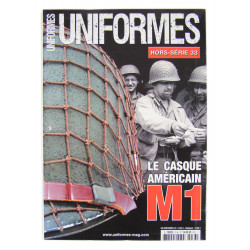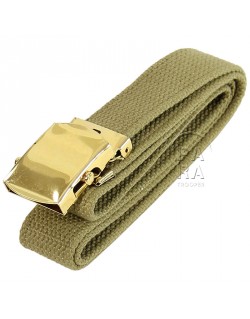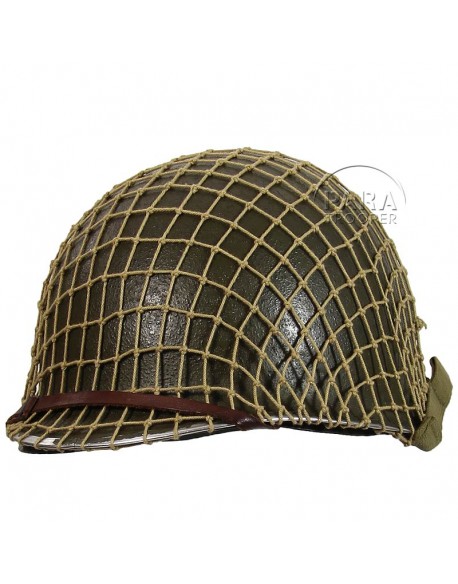



Net, helmet, M1, medium-mesh, kaki
Excellent reproduction of the American type medium-mesh net, khaki, used by many infantry and airborne divisions.
Fits perfectly on the US M1 helmet.
Product Details
You might also like
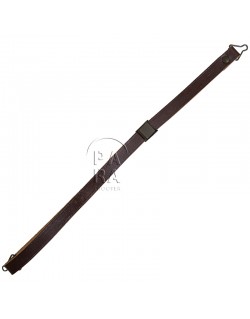
Strap, Leather, for M1 helmet, deluxe
Reproduction of the small leather strap for US liner, model 1943. Green buckle and hardware. Piece of tanned calf's leather and creases run along the edges. Reverse side is rough, like the original chinstrap. Speedy rivet fastener manufactured by Scovill, USA.
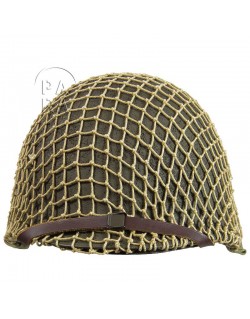
Helmet, M1, complete (SC)
Post war USM1 helmet, with fix loops and replica canvas straps, repainted with an original type cork, delivered with liner and camo net (according arrival). Perfect for reenacting. Early version commonly worn by all GIs in 1944.
Customers who bought this product also bought:
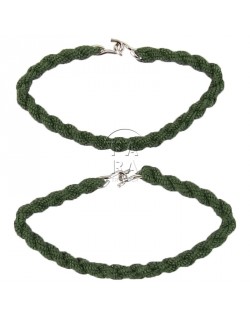
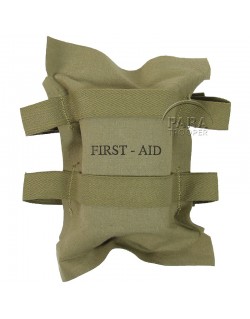
Pouch, First-Aid, Parachutist, Made in USA
Nice reproduction paratrooper aid pouch. Ties to your web gear, or to your helmet netting. The ties are 18" long, 3/4" cotton webbing. The body is khaki cotton, with the "FIRST AID" stamped in the middle like the originals. No medical items inside, made to resemble the bandage box. These insides won t crush, and won t get soft on you even if it gets wet. This is the best quality and price out there! Even with shipping, it is way under the price of the competition. Made in USA.
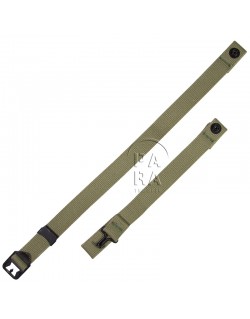
Straps, web, M1C helmet, Paratrooper, 2nd type
Pair of USM1C paratrooper helmet web straps, 2nd type with metal buckle, with the tab and snap system for keeping the shell and liner together.
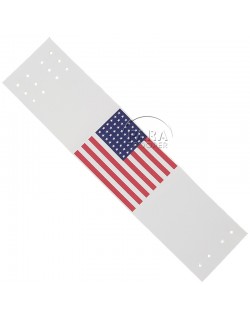
Armband (brassard) identification flag, invasion, US, 48 stars
Reproduction of the armband identification flag of 48 stars to be worn on the sleeve of invasion troops and paratroops in various assault operations. Issued to infantry and airborne troops and glider pilots in Normandy, Provence, Holland... The purpose of this armband was to identify the nationality of the wearer to the locals of the country being invaded. These oilcloth armbands had been around for a year or two before the 101st used them. U.S. amphibious forces had already worn arm brassards in 1942, in Operation Torch-the landings in North Africa. Brassards like those shown above were worn by everybody in the 101st Airborne during the Market-Garden operation, photographic evidence indicates that they were also worn by Glider pilots in Normandy. They were also generally worn by infantry and airborne troops during the Southern France landings of August 44 in Provence. Made in France.
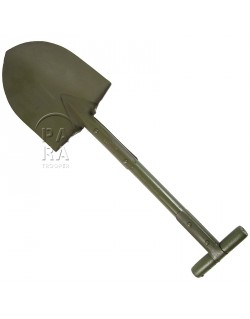
T-Shovel, US Army, M-1910
Reproduction of the US Army M-1910 T-Shovel, marked US SEMS 1942, in metal and wood. This shovel was used during the two World Wars, despite the appearance of the M-1943 folding shovel in 1943.
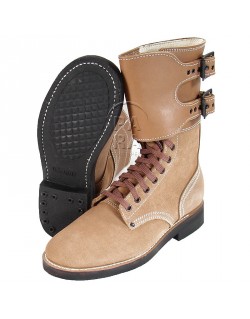
- On sale!
Boots, Service, Combat (Double Buckle Boots)
Very nice replicas of the US Army "Double Buckle" service shoe, made of rough out leather, fitted with an integral cuff, authorized in November 1943 to replace the previous combat shoe worn with the leggings, as well as the parachute jumper boots. The cuff, in tanned leather lined with white canvas, is tightened on the leg by two straps and buckles. The integral sole, including the instep, is made of black rubber. US sizes.

Grenade, MKII, metal
THIS ITEM IS NOT SHIPPED OUTSIDE FRANCE. MKII pineapple grenade in metal painted in green, perfect for re-enactment or mannekin.

Excellent reproduction of the American type medium-mesh net, khaki, used by many infantry and airborne divisions.
Fits perfectly on the US M1 helmet.
check_circle
check_circle
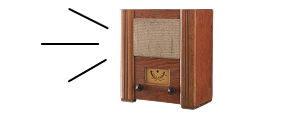
The historical artifacts for sale at PARATROOPER’s are intended for collectors, history enthusiasts, historians and museum curators.
These items do not glorify or promote any of the political, ideological or racial opinions related to the global conflicts that bathed the 20th century in blood.
Besides, we remind you that Article R.645-1 of the French Penal Code establishes fines applicable to fifth class contraventions (except in the specific cases of a filming, show or exhibition which refer to historical events) for any individual who wears a uniform, insignia or symbol reminiscent of those worn by members of the various organizations declared criminal in application of Article 9 of the Charter of the International Military Tribunal annexed to the London Agreement of August 8, 1945 – SS, SD, Gestapo, Nazi leaders (the Führer, the Reichsleitung, the Gauleiters and their main collaborators, the Ortsgruppenleiter, the Zellenleiter and the Blockleiter), or reminiscent of those worn by any person found guilty, by a French or International Jurisdiction, of one or several crimes against humanity established by Articles 211-1 to 212-3 or mentioned in Law No. 64-1326 of December 26, 1964.
The Code provides additional penalties, including the confiscation of the items used or intended for committing the offence.




